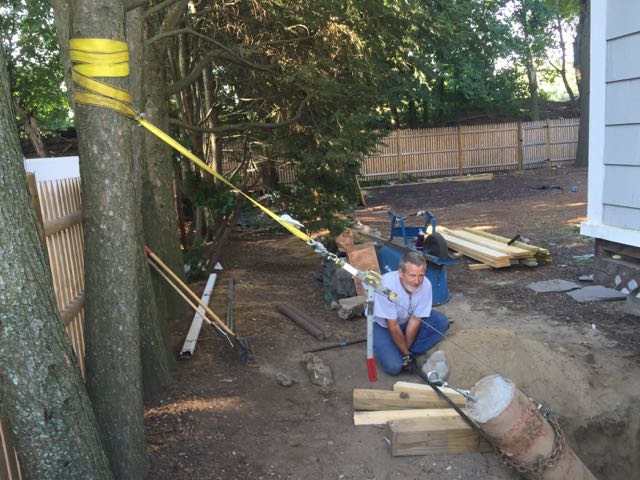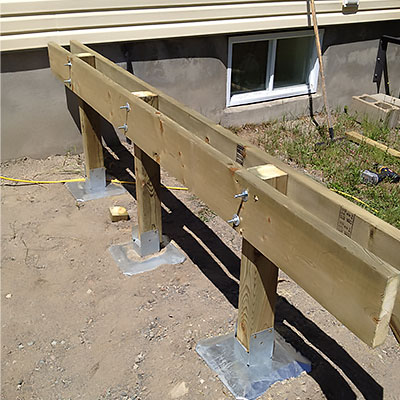Picking the Right Deck Footings for Security and Resilience
The long life and safety and security of your deck depend greatly on the kind of footings you pick, as they provide the essential assistance and security to hold up against the test of time. In this conversation, we will explore the various types of deck grounds, consider the important elements to consider when making a choice, and dive right into the pros and cons of various alternatives.
Sorts Of Deck Footings
There are numerous kinds of deck footings that can be made use of, each offering distinct benefits and factors to consider. One common sort of footing is the concrete pier ground. These footings include a cylindrical hole loaded with concrete, which supplies a solid structure for the deck articles. Concrete pier grounds are fairly very easy to set up and offer outstanding security, making them a prominent option for several deck jobs.
These grounds are installed by screwing them right into the ground, which creates a safe and secure foundation for the deck. They also allow for easy change and progressing of the deck if required.
Alternatively, some builders go with precast concrete grounds. These footings are made of durable concrete and be available in numerous shapes and dimensions to accommodate various deck layouts. Precast concrete footings are hassle-free to install and give a steady base for the deck structure.
Ultimately, another alternative is the post-in-anchor footing system. This kind of ground includes driving a metal support into the ground and affixing it to the deck post. It provides flexibility in regards to positioning the deck messages and appropriates for decks with lightweight structures.
When selecting the appropriate type of deck ground, it is important to consider variables such as soil problems, deck lots, and regional building codes (Deck Footings). Consulting with an expert specialist or architectural engineer can help make certain the suitable footing is selected for a safe and steady deck
Variables to Think About When Choosing Footings
When selecting the ideal grounds for a deck, it is essential to very carefully take into consideration different elements such as soil conditions, deck tons, and adherence to regional structure codes. These factors play a considerable function in making certain the security and toughness of the deck framework.
The type of soil on which the deck will be constructed determines the kind of grounds needed. On the other hand, decks developed on clay or expansive soils might call for grounds that can suit the dirt's tendency to increase and agreement.
One more essential factor is the deck tons. The weight of the deck, including the products utilized and any type of potential online lots such as furnishings or celebrations, need to be taken right into account when selecting footings. The footings need to be created to bear the weight of the deck and distribute it evenly to protect against any kind of structural concerns or failings.
Last but not least, adherence to regional building regulations is critical. Building regulations vary from area to area, and it is vital to conform with the specific requirements established by the neighborhood authorities. Deck Footings. These codes make sure that the deck is built securely and meets the needed criteria for architectural stability and load-bearing ability
Concrete Grounds: Advantages And Disadvantages

Concrete footings supply several benefits and downsides when made use of as the structure for a deck. On the positive side, concrete grounds supply outstanding security and longevity. Concrete is a solid and rigid material that can support heavy loads and stand up to numerous weather. It additionally has a lengthy life expectancy, making it a dependable choice for long-term usage.
One more advantage of concrete footings is their flexibility. They can be put right into different shapes and sizes to fit different deck styles and configurations. Concrete footings can be tailored to fit the details demands and needs of the deck framework.
Nevertheless, there are also some drawbacks to making use of concrete grounds. This can enhance the overall price of the deck task and may require specialist aid.

Helical Piers Vs. Sonotubes: Which Is Better?
In considering the structure alternatives for a deck, the comparison in between helical piers and sonotubes is vital in identifying the exceptional option. Helical piers, likewise called screw stacks, are steel shafts with helical plates affixed to them. They are turned into the ground making use of hydraulic equipment, providing a long lasting and stable foundation for the deck. On the other hand, sonotubes are cylindrical forms made of cardboard or fiber product that are full of concrete. They are put in a hole went into the use this link ground and offer support for the deck.
The helical plates on the piers create a solid hold with the soil, changing or avoiding any kind of motion of the deck. Sonotubes, on the various other hand, depend only on the concrete filling up for security, which may not supply the same degree of strength and resistance.
In regards to installation, helical piers are fairly simpler and faster to mount compared to sonotubes. The hydraulic equipment used to twist the piers right into the ground makes sure a efficient and quick procedure. Sonotubes, on the other hand, need excavating holes and putting concrete, which can be labor-intensive and lengthy.
In addition, helical piers are an even more functional choice. If needed, they can here are the findings be used in different soil conditions and can be readjusted or enhanced. Sonotubes, on the other hand, may need extra assistance, such as rebar, in particular soil conditions or areas with high tons requirements.
Selecting the Right Footings for Your Deck's Dimensions
For ideal architectural honesty, it is important to carefully select the proper grounds that straighten with the dimensions of your deck. The dimensions of your deck, including its size, elevation, and length, play a significant duty in figuring out the type and dimension of grounds needed.
When picking footings for your deck, it is necessary to think about the load-bearing ability of the dirt. The weight of the deck, integrated with the weight of any kind of furniture or individuals on it, applies a significant pressure on the grounds (Deck Footings). Consequently, it is important to pick grounds that can sufficiently support this weight without sinking or changing over time.
Bigger decks with greater dimensions need larger grounds to provide enough stability and assistance. The shape of the grounds, whether they are square or rounded, depends on the style and format of the deck.
Final Thought
In conclusion, picking the best deck grounds is critical for making certain stability and durability. Variables such as the sort of footings, the deck's measurements, and the advantages and disadvantages of various choices ought to be considered. Concrete footings offer strength and long life, however might be a lot more taxing and costly to install. Helical piers and sonotubes have their very own advantages and negative aspects. Eventually, picking the ideal footings for your deck's certain requirements is essential for a successful and click here for more long-lasting framework.
These footings are composed of a round hole filled up with concrete, which gives a solid structure for the deck blog posts. Concrete pier footings are reasonably very easy to install and provide excellent stability, making them a preferred option for lots of deck projects.
Precast concrete grounds are convenient to mount and give a steady base for the deck framework.
It provides flexibility in terms of placing the deck posts and is ideal for decks with light-weight frameworks.
Concrete grounds offer a number of advantages and negative aspects when utilized as the foundation for a deck.